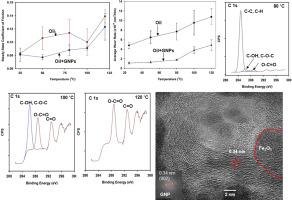高温下石墨烯纳米片在机油中的摩擦化学稳定性和摩擦机制
IF 5.1
3区 材料科学
Q2 MATERIALS SCIENCE, COATINGS & FILMS
引用次数: 0
摘要
通过25℃至120℃的钢对钢滑动试验,研究了石墨烯纳米片(GNPs)作为边界润滑添加剂在发动机油中的摩擦化学行为和热稳定性。在25°C时,GNPs对摩擦系数的影响可以忽略不计,COF:仅油为0.083,油+ GNPs为0.081)。在50°C和80°C时,COF随GNP的增加而显著下降,分别从0.106降至0.077(~ 27%)和从0.114降至0.088(~ 22%)。在120°C时,仅观察到适度的降低(0.139至0.123),表明添加剂在高温下的有效性下降。拉曼和x射线光电子能谱(XPS)分析表明,摩擦层在~ 80°C时保持化学稳定,主要存在C - C/C - h键和有限的结构紊乱。在80℃及以上,氧化变得明显,转变为O - C=O, D和D '波段强度增加。在富Fe₂O₃的摩擦膜中,石墨烯层发生弯曲和断裂,层间间距增加到0.34 ~ 0.36 nm。这些结果表明,GNPs通过形成富碳摩擦层来减少摩擦和磨损,但在80°C附近开始的氧化和结构降解限制了它们在高温下的稳定性。研究结果揭示了- GNPs在边界润滑条件下的温度依赖结构演变,并表明需要采取稳定策略来延长GNPs的高温摩擦学性能。本文章由计算机程序翻译,如有差异,请以英文原文为准。

Tribochemical stability and friction mechanisms of graphene nanoplatelets in engine oil at elevated temperatures
The tribochemical behaviour and thermal stability of graphene nanoplatelets (GNPs) as boundary-lubricating additives in engine oil were investigated through steel-on-steel sliding tests from 25 °C to 120 °C. At 25 °C, GNPs had negligible effect on coefficient of friction, COF: 0.083 in oil-only vs. 0.081 in oil + GNPs). At 50 °C and 80 °C, the COF decreased significantly with GNP addition—from 0.106 to 0.077 (∼27 %) and from 0.114 to 0.088 (∼22 %), respectively. At 120 °C, only a modest reduction was observed (0.139 to 0.123), indicating a decline in additive effectiveness at elevated temperature. Raman and X-ray photoelectron spectroscopy (XPS) - analysis showed that the tribolayer remained chemically stable up to ∼80 °C, with predominant C–C/C–H bonding and limited structural disorder. At and above 80 °C, oxidation became evident, with a shift to O–C=O species and increased D and D′ band intensities. HR-TEM revealed bending and fragmentation of graphene layers embedded within an Fe₂O₃-rich tribofilm, with interlayer spacings increasing to 0.34–0.36 nm. These results indicate that GNPs reduce friction and wear by forming a carbon-rich tribolayer, but oxidation and structural degradation beginning near 80 °C limit their stability at higher temperatures. The findings provide insight into the temperature-dependent structural evolution of - GNPs under boundary-lubricated conditions and suggest the need for stabilization strategies to extend GNPs high-temperature tribological performance.
求助全文
通过发布文献求助,成功后即可免费获取论文全文。
去求助
来源期刊

Diamond and Related Materials
工程技术-材料科学:综合
CiteScore
6.00
自引率
14.60%
发文量
702
审稿时长
2.1 months
期刊介绍:
DRM is a leading international journal that publishes new fundamental and applied research on all forms of diamond, the integration of diamond with other advanced materials and development of technologies exploiting diamond. The synthesis, characterization and processing of single crystal diamond, polycrystalline films, nanodiamond powders and heterostructures with other advanced materials are encouraged topics for technical and review articles. In addition to diamond, the journal publishes manuscripts on the synthesis, characterization and application of other related materials including diamond-like carbons, carbon nanotubes, graphene, and boron and carbon nitrides. Articles are sought on the chemical functionalization of diamond and related materials as well as their use in electrochemistry, energy storage and conversion, chemical and biological sensing, imaging, thermal management, photonic and quantum applications, electron emission and electronic devices.
The International Conference on Diamond and Carbon Materials has evolved into the largest and most well attended forum in the field of diamond, providing a forum to showcase the latest results in the science and technology of diamond and other carbon materials such as carbon nanotubes, graphene, and diamond-like carbon. Run annually in association with Diamond and Related Materials the conference provides junior and established researchers the opportunity to exchange the latest results ranging from fundamental physical and chemical concepts to applied research focusing on the next generation carbon-based devices.
 求助内容:
求助内容: 应助结果提醒方式:
应助结果提醒方式:


